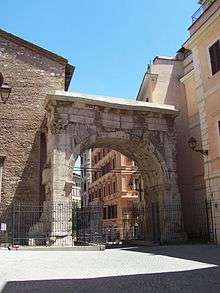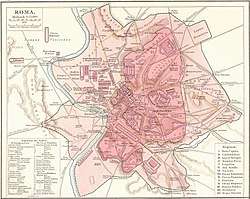Arch of Gallienus
| Arch of Gallienus | |
|---|---|
 | |
| Location | Regione V Esquiliae |
| Built in | built during the Augustan age, rededicated in 262 |
| Built by/for | unknown (rededicated by Marcus Aurelius Victor) |
| Type of structure | Arch |
| Related |
List of ancient monuments in Rome |
 Arch of Gallienus | |
The Arch of Gallienus is a name given to the Porta Esquilina, an ancient Roman arch in the Servian Wall of Rome. It was here that the ancient Roman roads via Labicana and via Tiburtina started.
History
The arch was rebuilt in monumental style in the Augustan period.[1] It was not intended to be a triumphal arch but to serve as a gateway in the Republican city wall of Rome.[2] In 262, the equestrian (Marcus) Aurelius Victor,[3] member of the imperial household, rededicated the arch to the emperor Gallienus and his wife, Salonina, by replacing the original inscription.[2] The purpose of the rededication was to balance the negative publicity which Gallienus had earned due to the various setbacks the Empire had suffered during his reign.[2]
Site

It still stands in the Via di S. Vito (the ancient Clivus Suburanus - the sequel, the Via S. Madonna dei Monti, follows the course of the ancient Argiletum, the main road to the Roman Forum).
Already in the Augustan period the Porta Esquilina should be included in the Esquiline Forum, that included the market called the Macellum Liviae. When these buildings were abandoned in late antiquity, the diaconia and monastery of San Vito (cited in the Einsiedeln Itinerary) took them over, cited already in the itinerary of Einsiedeln. It is this church against which the arch's remains now rest.
Architecture
The surviving single arch is of travertine, 8.80 metres high, 7.30 wide, and 3.50 deep. It is supported by piers which are 1.40 metres wide and 3.50 deep. Outside of these piers, there are two pilasters of the same depth, stemmed by Corinthian capitals. The pillars support an horizontal entablature which is 2 metres high and contains a dedicatory inscription on the architrave. There is a simple cornice on each side of the arch, beneath its spring. A drawing of the 15th century shows small side arches.[4] These pedestrian arches were demolished during the 15th century.[5]
Inscription
GALLIENO CLEMENTISSIMO PRINCIPI To Gallienus, the most clement princeps, CVIVS INVICTA VIRTVS SOLA PIETATE whose unconquered virtus is only outdone SVPERACTA EST ET SALONINAE by his pietas, and to Salonina, SANCTISSIMAE AVGVSTAE AVRELIVS most holy Augusta, Aurelius VICTOR V[ir] E[gregius] DICTATTISSIMVS Victor, the excellent man,
[dedicated this] in complete devotionNVMINI MAIESTATISQVE EORVM to their numines and majesties
These two surviving lines represent the end of an inscription.[6] The large rectangular blank space above them had marble slabs fixed onto it, with the beginning of the inscription - the drilled holes for these slabs' metal fixings are still visible. The missing part of the inscription probably named the emperor Valerian, father of Gallienus who was captured by the Sassanid Persians in 260.[5]
References
- ↑ Thein, Alexander. "Porta Esquilina" in Digital Augustan Rome.
- 1 2 3 Southern, Patricia (2015). The Roman Empire from Severus to Constantine. Routledge. p. 136. ISBN 1317496949.
- ↑ Mennen, Inge. "Power and Status in the Roman Empire, AD 193-284" in Volume 12 of The Impact of Empire, Koninklijke Brill, Leiden, the Netherlands, 2011. Page 230.
- ↑ "LacusCurtius • Arches of Ancient Rome (Platner & Ashby, 1929)". penelope.uchicago.edu. Retrieved 2017-12-31.
- 1 2 Claridge, Amanda (2010). Rome: An Oxford Archaeological Guide. Oxford University Press. p. 335. ISBN 9780199546831.
- ↑ CIL VI.1106; ILS 548
Sources
- Corpus Inscriptiorum Latinarum VI.1106
Coordinates: 41°53′45″N 12°30′05″E / 41.895779°N 12.501361°E